The printing industry has long grappled with its environmental impact, but here’s the good news: you don’t have to sacrifice quality for sustainability.
Whether you’re running a professional print shop or managing an office printer, there are numerous ways to reduce your carbon footprint while still producing stunning prints.
Let’s dive into some game-changing strategies that help both the planet and your print quality.
Understanding the Environmental Impact of Printing
Before we jump into solutions, it’s worth understanding what we’re dealing with. The printing industry contributes to environmental concerns through paper consumption, energy usage, and chemical waste. However, modern technology and innovative practices have opened up new possibilities for sustainable printing without compromising on quality.
The Hidden Costs of Traditional Printing
Traditional printing methods often waste more resources than you might realize. From paper scraps and excess ink to energy-intensive processes, these hidden costs add up both environmentally and financially. But here’s where it gets interesting: many of the practices that reduce environmental impact actually improve print quality and reduce costs.
Smart Paper Choices
The Right Paper Makes All the Difference
Let’s talk paper – it’s not just about recycled versus virgin anymore. Today’s recycled papers come in various grades and finishes that rival or exceed traditional papers in quality. Look for papers certified by the Forest Stewardship Council (FSC) or Programme for the Endorsement of Forest Certification (PEFC). These papers not only support sustainable forestry but often provide better color reproduction and less dust during printing.
Weight Matters
Here’s a pro tip: lighter paper doesn’t always mean lower quality. Many premium papers are now available in lighter weights that maintain opacity and printing quality while reducing material usage and shipping costs. For instance, switching from 100gsm to 80gsm paper can reduce your paper consumption by 20% without noticeable quality loss in most applications.
Optimizing Your Digital Workflow
Prepress Excellence
The secret to reducing waste while maintaining quality often lies in your prepress workflow. Modern prepress software can help you optimize ink coverage, reduce paper waste through better imposition, and ensure color accuracy before a single sheet is printed. This not only saves resources but often results in better print quality and consistency.
Color Management Magic
Proper color management isn’t just about quality – it’s about sustainability too. By implementing a robust color management system, you can reduce the number of reprints needed to achieve the desired results. This means less waste and more predictable outcomes. Consider investing in spectrophotometers and color management software – they typically pay for themselves through reduced waste alone.
Eco-Friendly Inks and Toners
The New Generation of Sustainable Inks
Modern eco-friendly inks have come a long way. Today’s vegetable-based and low-VOC inks not only reduce environmental impact but often provide better color vibrancy and faster drying times than traditional petroleum-based inks. Plus, they make paper recycling easier and reduce harmful emissions during the printing process.
Smart Toner Usage
For digital printing, newer toner technologies require lower fusing temperatures, which means less energy consumption. Look for printers with these advanced toners – they often provide better color accuracy and finer detail while using less energy. Some manufacturers now offer toner cartridge recycling programs, creating a closed-loop system that reduces waste.
Energy-Efficient Equipment Choices
The Power of Modern Technology
Today’s printing equipment often comes with sophisticated power management features. Look for ENERGY STAR certified devices that automatically enter sleep mode during idle periods but maintain quick start-up capabilities. These features can reduce energy consumption by up to 30% without impacting productivity.
Maintenance Matters
Regular maintenance isn’t just about keeping your equipment running – it’s about maintaining efficiency. Clean, well-maintained printers use less energy and produce better quality prints. Schedule regular maintenance checks and cleaning to ensure optimal performance and energy efficiency.
Process Optimization
The Beauty of Automation
Automated workflows reduce human error and waste while improving consistency. Consider implementing automated preflight checks, digital proofing systems, and job scheduling tools. These not only reduce waste but often lead to higher quality output through standardized processes.
Batch Processing Benefits
Instead of printing jobs as they come in, batch similar jobs together. This reduces energy usage from printer warm-up cycles and allows for more efficient use of materials. Modern workflow software can help optimize job batching while maintaining delivery schedules.
Measuring and Monitoring
Track Your Progress
Implement systems to track your resource usage and waste production. Many modern printers come with built-in monitoring tools that can help you identify areas for improvement. Regular monitoring helps you maintain quality standards while continuously reducing your environmental impact.
Employee Training
Well-trained staff are crucial for maintaining both quality and sustainability. Regular training sessions on best practices, new technologies, and environmental initiatives ensure everyone understands their role in reducing the company’s carbon footprint while maintaining high-quality standards.
By implementing these strategies, you’ll not only reduce your environmental impact but often find that print quality improves as well. The key is to view sustainability not as a compromise but as an opportunity to optimize your printing processes for both quality and efficiency. Remember, small changes add up to significant impacts over time, both for the environment and your bottom line.



